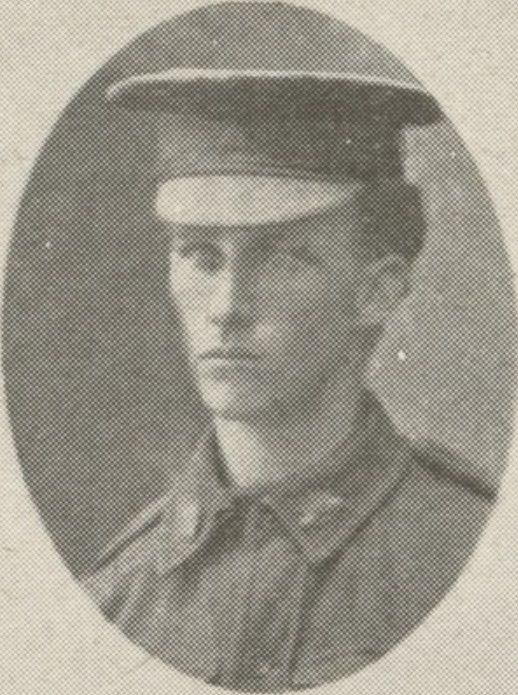Pte
Bertie Cecil Kessels
Information about birth
|
Date of birth: 03/06/1894 |
|
Place of birth: Brisbane, Queensland, Australia |
General information
|
Last known residence: Degilbo, Queensland, Australia |
|
Profession: Farmer |
|
Religion: Roman Catholic |
Army information
|
Country: Australia |
|
Force: Australian Imperial Force |
|
Rank: Private |
|
Service number: 3511 |
|
Enlistment date: 18/10/1916 |
|
Enlistment place: Maryborough, Queensland, Australia |
|
Units: — Australian Infantry, 47th Bn. (Last known unit) |
Information about death
|
Date of death: 12/10/1917 |
|
Place of death: Decline Copse, Passchendaele, Belgium |
|
Cause of death: Killed in action (K.I.A.) |
|
Age: 23 |
Cemetery
|
Tyne Cot Cemetery Plot: XL Row: C Grave: 24 |
Distinctions and medals 2
|
British War Medal Medal |
|
Victory Medal Medal |
Points of interest 3
| #1 | Place of birth | ||
| #2 | Enlistment place | ||
| #3 | Place of death (approximate) |
My story
Bertie Cecil Kessels was the youngest in a family of as many as 9 children. He was born on June 3, 1894, the son of Nicolas and Elizabeth Kessels.
Bertie enlisted on Oct. 18, 1916, his older brother already serving as an officer in the Australian Army by then. On Jan. 24, 1917, he left the Australian mainland and on Aug. 4 joined the 47th Bn. Australian Infantry, part of the 12th Australian Brigade, 4th Australian Division. Only a few days later, on Aug. 19, 1917, he was wounded. On September 22, he rejoined the battalion.
This was in time for October 12, 1917, when the 4th Australian Division took part in the First Battle of Passchendaele, part of the Third Battle of Ypres which had been in progress since July 31, 1917. The 4th Australian Division's objective was to advance over the Broodseinde ridge to Keiberg Spur on October 12, 1917, to flank the 3rd Division which was advancing north of the railroad towards Passchendaele. The 47th Battalion was given the task of capturing and holding the red line. This ran roughly from the railroad embankment to Assyria. Then the 48th Battalion would continue the attack.
The attack faced immediate setbacks. The soldiers were tired from marching through the mud. The battalion headquarters, located in a bunker on the Broodseinde ridge, was also hit. Nearly all the signalmen and couriers had become casualties, making further communications more difficult. The Germans retreated, but once the 48th Battalion advanced they faced heavy German fire from Vienna Cottage. This was in the 3rd Division's sector, but heavy resistance had prevented them from advancing. They managed to eliminate the German position at Vienna Cottage, but finally, due to lack of support, 47th and 48th Battalions had to retreat to their starting positions. Both battalions lost a total of nearly 1,000 soldiers.
Bertie Cecil Kessels was one of those killed; he was found after the war and exhumed east of Declining Copse. He was reburied and currently rests in Tyne Cot Cemetery. He was 23 years old.
Bertie enlisted on Oct. 18, 1916, his older brother already serving as an officer in the Australian Army by then. On Jan. 24, 1917, he left the Australian mainland and on Aug. 4 joined the 47th Bn. Australian Infantry, part of the 12th Australian Brigade, 4th Australian Division. Only a few days later, on Aug. 19, 1917, he was wounded. On September 22, he rejoined the battalion.
This was in time for October 12, 1917, when the 4th Australian Division took part in the First Battle of Passchendaele, part of the Third Battle of Ypres which had been in progress since July 31, 1917. The 4th Australian Division's objective was to advance over the Broodseinde ridge to Keiberg Spur on October 12, 1917, to flank the 3rd Division which was advancing north of the railroad towards Passchendaele. The 47th Battalion was given the task of capturing and holding the red line. This ran roughly from the railroad embankment to Assyria. Then the 48th Battalion would continue the attack.
The attack faced immediate setbacks. The soldiers were tired from marching through the mud. The battalion headquarters, located in a bunker on the Broodseinde ridge, was also hit. Nearly all the signalmen and couriers had become casualties, making further communications more difficult. The Germans retreated, but once the 48th Battalion advanced they faced heavy German fire from Vienna Cottage. This was in the 3rd Division's sector, but heavy resistance had prevented them from advancing. They managed to eliminate the German position at Vienna Cottage, but finally, due to lack of support, 47th and 48th Battalions had to retreat to their starting positions. Both battalions lost a total of nearly 1,000 soldiers.
Bertie Cecil Kessels was one of those killed; he was found after the war and exhumed east of Declining Copse. He was reburied and currently rests in Tyne Cot Cemetery. He was 23 years old.
Connection to other soldiers 1
|
Leonard Claus Kessels
Brother |
Sources 3
|
Deayton Craig , Battle Scarred: the 47th Battalion in the First World War (Newport Big Sky publishing Ltd, 2011).156-188. Sources used |
|
First Australian Imperial Force Personnel Dossiers, 1914-1920 (National Archives of Australia, Canberra (NAA), B2455, Kessels, Berthie Cecil). https://recordsearch.naa.gov.au/ Sources used |
|
McCarthy, Chris. Passchendaele: The Day by Day Account (Londen: Arms & Armour Press, 2018), 129-132. Sources used |
More information 4
|
CWGC https://www.cwgc.org/find-records/find-war-dead/casualty-details/463469 |
|
Lives of the First World War (Imperial War Museum) https://livesofthefirstworldwar.iwm.org.uk/lifestory/7504268 |
|
Namenlijst (In Flanders Fields Museum) https://namenlijst.org/publicsearch/#/person/_id=36450428-5be3-4ae4-88f5-6578bb3f14ef |
|
The AIF Project (UNSW Canberra) https://aif.adfa.edu.au/showPerson?pid=164160 |
